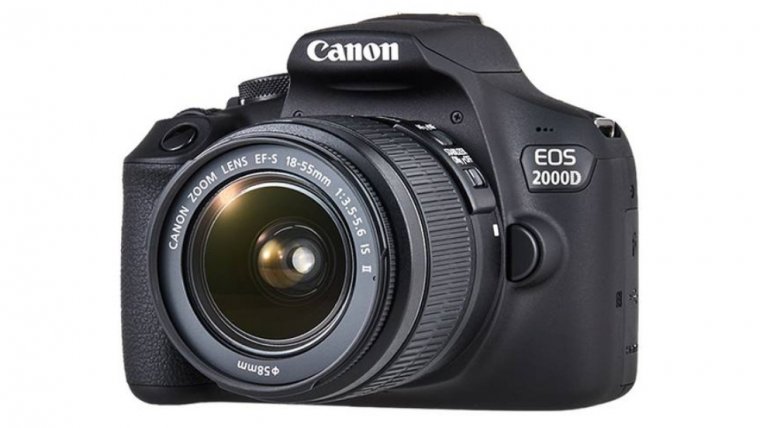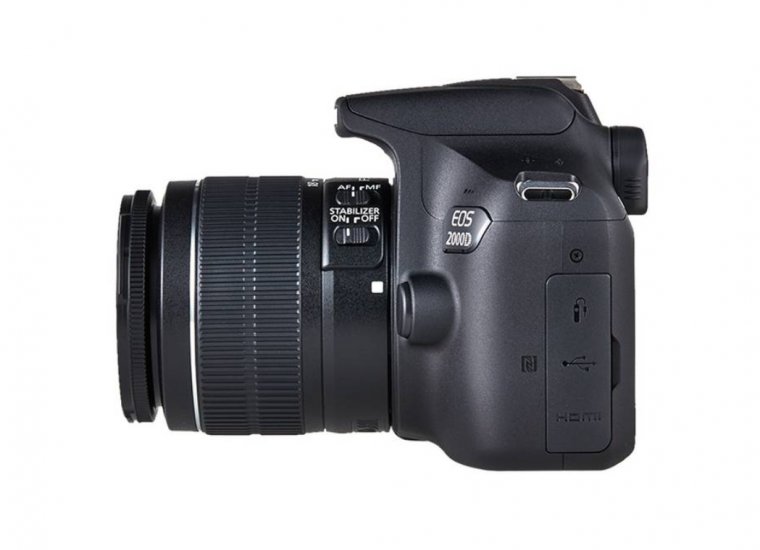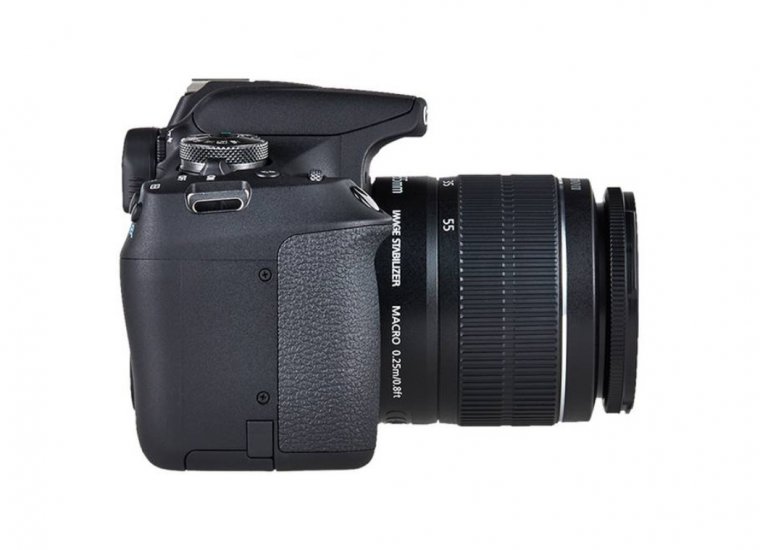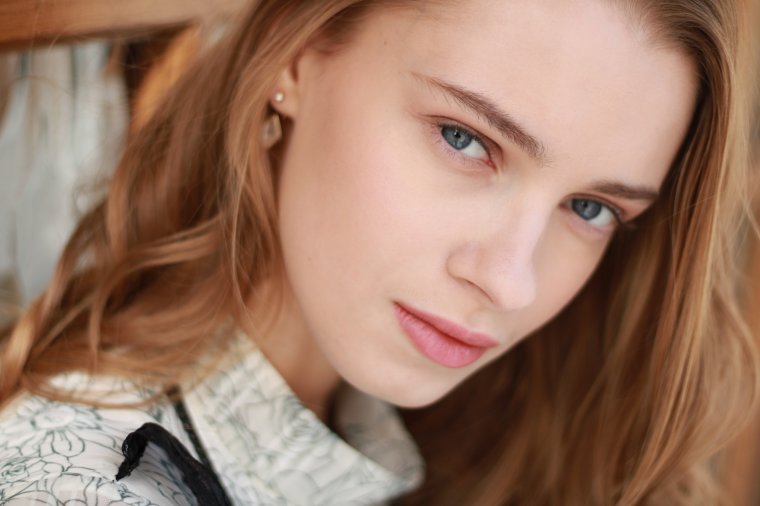
While the popularity of mirrorless cameras is constantly rising with each passing year (and the interest for compact cameras and DSLRs is in slow decline) we are still far from reaching that point of time in which they could be considered irrelevant and thus a lot of manufacturers are still set on releasing new models in both of these categories in 2018 as well. Today, we have one of the newest representatives of affordable DSLR cameras and that is the Canon EOS 2000D.
It is the successor to the Canon 1300D and finally marks somewhat of a bigger upgrade over the 1000D line up and that’s mainly because of the addition of a new 24-megapixel sensor (which replaces a decade old 18-megapixel one that has found its way in many of Canon’s cameras up until now) and more usable burst performance (although at the same speed as before). Other than that, we are dealing with a pretty much the same camera as the older 1300D, which puts the 2000D in quite an interesting position.
On its own, it sounds like a decently capable best camera for a budget DSLR, but it may not bring enough new features to entice the owners of its predecessor to make the upgrade. So, it is mostly aimed at a newer generation of beginner and amateur photographers and we will treat it as its own entity through this review. But then if you’re looking for a back up camera, you can try looking for Canon PowerShot G5 X. So, let us begin by taking a detailed look at its specifications.
Table of Contents
As we’ve already established, the Canon EOS 2000D is a camera that will mostly appeal to those looking for the most basic and straightforward DSLR experience that you could find among today’s cameras. The design language featured on this model is exactly what you would expect from a traditional Canon DSLRs and considering that it has worked very well in the past we aren’t surprised at all that not much has changed this time around. It’s the same agronomical shape that we all love and appreciate from a DSLR, logical button arrangement that will be familiar to anyone that has used a DSLR before and easy to figure out to any newcomers and the same build quality you’d expect from an entry-level Canon (plastic construction but put together very well and without making the camera feel like a cheaply put product).
Since it’s smaller than most of prosumer and professional DSLRs, it isn’t as comfortable to hold due to smaller and shallower grip, but it’s still in a different league when it comes to its ergonomics if you compare it to your traditional compact or mirrorless camera and does serve its purpose. We also like that it’s quite a light camera (only 475 grams together with the battery) and thus will be easy to carry around often for many people, despite it being bigger than a point-and-shoot or your smartphone. Pair it with a nice compact lens such as the Canon 40mm f2.8 or 50mm f1.8 and you’ll be getting a very portable package capable of taking some lovely photos in most of the lighting conditions. Now, it would be nice if Canon went one step further and managed to include a touch-enabled screen because many people buying the 2000D will be coming from their smartphones and would feel right at home with controlling their new camera via touch input, but on the other hand, giving people the chance to really learn how to use a proper camera the more traditional way (with the help of physical controls) is not such a bad thing at all and is still one of the most preferred ways of interacting with their DSLRs and mirrorless cameras for most photographers out there.
Now that we’ve given you some insight of what you can expect out of the Canon EOS 2000D from the standpoint of handling and usability, it is only natural that we explain and describe some of its physical aspects in more detail and take a quick look around its body. Let’s start with the front. Other than the obligatory Canon and EOS logos, the only other things that stand out here are the Red-eye reduction/Self-timer lamp, the lens release button, a single mono microphone and the lens mount itself. Switching our attention to one of the sides of the camera reveals the micro-HDMI, micro-USB and remote-control terminals (ports) as well as the NFC contact point located on the left and the DC cord hole and the SD card slot on the right side. As usual, the tripod mount socket and the battery compartment are both located at the bottom of the 2000D. The top part of this camera houses the speaker, a hot shoe mount, pop-up flash unit (which can also be used to assist the AF system in low light conditions), the main mode dial, a power switch, the flash button, main control dial and lastly, the shutter button. The only remaining thing that needs to be taken care of is to see what the back of the camera holds, so let’s dig in. The back itself is dominated by the 3-inch LCD screen and the optical viewfinder and the rest of its important attributes consist of the dioptric adjustment knob, Live view shooting/Movie shooting button, the Display (DISP) button, AE lock/FE lock/Index/Reduce and AF point selection/Magnify buttons, the Aperture/Exposure compensation/Erase and Quick Control (Q) buttons, the main four-way navigation controller with four buttons of its own (ISO, White balance, Drive/Self-timer and AF operation selection), the SET (or confirmation button) and lastly, the Menu and the Playback buttons as well as the little Wi-Fi activity and the access lamps. So, despite not featuring the control scheme of a more advanced camera, the actual number of available controls isn’t bad at all, as most of the important settings and functions are already covered well and available with a touch of a button (or a spin of a dial, if you wish). What’s also helpful and ties in with very well with the camera’s good usability is Canon’s well-designed user interface, menu system and helpful features and modes that will be of great assistance to amateur and beginner photographers. The interface itself is easy to navigate, all of its aspects are nicely labeled and color coded, no menus or functions ever feel out of place and the overall great performance and responsiveness is just the cherry on the cake and continues to portray Canon as one of the best in business when it comes to backing up their cameras with quality software.

The camera’s main modes are split into two categories: Creative Zone (which includes all of the advanced modes that will let you take control over your exposure and the Basic Zone (which consists of the Scene Intelligent Auto, Flash Off Creative Auto and Movie Shooting modes, as well as the separate modes optimized for different types of photography such as Portrait, Landscape and Close-up). Most of you, however, will be spending your time inside the Scene Intelligent Auto mode (at least until you’ve learned all the basics about exposure, composition and focus modes) and it’s good to know that the said mode will automatically choose the right exposure settings based on the scene you’re trying to take the picture of an even switch to the appropriate focusing mode if it detects a moving subject in your frame. After you become ready to tackle more advanced settings and functions, you will mostly be using the Quick Control Menu (activated by pressing the Q button located on the back of the camera as it will provide you with a simple and easy to navigate collection of all the most important settings you’ll have to deal with (like Shutter Speed, Aperture, ISO, Picture Style, White Balance and more). Shooting through the viewfinder will also allow you to change all of the important exposure settings and see them change in real time, which should be your preferred method of using the camera in extreme lighting conditions (where it’s hard to see the screen) or when you need to keep an eye on your endurance since the optical viewfinder itself doesn’t waste a lot of battery life.
When it comes to helping you learn the importance of color balance of your images and giving them the right feel, the addition of the Ambience Settings will allow you to give your photos unique characteristics (you’ll be able to choose from Standard, Vivid, Soft, Warm, Intense, Cool, Brighter, Darker and Monochrome settings). Let us also touch on customization for a moment. There are two important aspects to keep in mind: The Custom Functions and the My Menu sections. The Custom Functions menu will give you the ability to set things like Exposure level increments, ISO expansion, Assign SET button, Flash button function and more, while the My Menu option is a separate menu dedicated to putting all of your secondary settings and functions that you won’t be using all the time, but would still like to access quickly without having to dig through the menus.
Lastly, let us talk about Wi-Fi capabilities, as the Canon EOS 2000D certainly has a lot to offer in this area. Its wireless functionality is split into five main areas: Connection with a smart device (tablet or a smartphone, even via NFC-enabled Android device), Image transfer between cameras, Image printing via compatible Wi-Fi printer, Saving photos to an optional Canon Connect Station accessory and also Sending images to a Web service of your choice (either a social network or Canon’s own iMAGE GATEWAY cloud service). To connect the 2000D with your smartphone or a tablet you’ll need to download and install the necessary Camera Connect application, so do keep that in mind before attempting to establish the connection between the DSLR and your smartphone. Doing so will allow you to make use of the important features such as viewing images stored on your camera’s SD card, saving them to your smartphone, change some of the camera’s settings or use your smart device as a remote viewfinder with the help of the Remote live view shooting option. Sadly, the ability to use your phone’s GPS system to send location info the camera is not supported and that could be considered another cost-saving measure and to separate the 2000D from Canon’s more advanced models like Canon 1D X MarkII

So, in the end, the Canon EOS 2000D performed exactly as we’ve expected it to during our first series of tests. It features a well-built and light body, decently balanced control scheme, average but useful viewfinder and screen units, excellent user interface and very nice set of Wi-Fi features. Some cost saving measures were applied here in terms of the available ports (the lack of the headphone and microphone jacks), the omission of a touchscreen and the lack of any GPS functionality, but considering the fact that we’re dealing with the Canon’s least expansive new DSLR model it comes as no surprise that such features are missing and doesn’t at all diminish the fact that the 2000D still presents itself as a good value for those that want a simple to use, but reliable DSLR camera.
The trend of offering a set of basic, but useful and trustworthy features also continues to the focusing capabilities of the Canon EOS 2000D. It’s 9-point phase detect AF system doesn’t feature any state of the art technology, but rather one that has already been the part of many of Canon’s other entry-level DSLRs through the years and has provided beginner photographers good enough performance to be able to capture quality photos in most situations. If you happen to shoot in daylight and moving subjects aren’t your priority, then you will have no problem with focusing quickly and accurately as the benefits of the phase detect technology is still present here despite the small number of focus points the camera has to work with.
Tracking performance is another matter though. While you should be able to capture some photos of people, pets and other subjects that aren’t moving in any wildly unpredictable manner (if you happen to own some of Canon’s newer STM or USM lenses), you shouldn’t expect to get a very high rate of perfectly focused images for anything more demanding. On the positive side, the included 3-fps burst rate (while not a terribly quick speed by itself) works very well thanks to the unlimited JPEG buffer that goes together with it and will at least allow you to shoot away as long as you have enough space left on your memory card and thus increase your chance of getting more usable images in the end. When it comes to low light performance, the AF system proved to behave decently well, but still not on par with more advanced cameras out there and the use of manual focusing is advised for the most critical shots and the darkest scenes you found yourself in.

Now, no DSLR would be complete without a number of focusing modes to choose from, so let’s see what the Canon EOS 2000D has to offer in this regard. Besides the traditional MF (Manual Focus Mode) you’ll also be able to pick one of three AF modes: One-Shot (best suited for shooting moving subjects and will only try to acquire focus once when you press the shutter button hallway), AI Servo (this is the mode to be in if you know you’ll be shooting moving subjects as it will allow the camera to refocus automatically if necessary and will do so until you let go of the shutter button) and lastly, AI Focus mode couples both the One-Shot and the AI Servo modes together and switches between them on the fly when the situation arises. If you wish to do so, you will also be able to specify the use of any of the available 9 focus points, use only the central one (which is the most accurate), use all of the available points or let the camera choose them for you. When it comes to the overall performance of the 2000D while it is being trifled with, we can only rate it as decent and that’s only because of its rather slow startup and write times.

The maximum burst rate of 3-fps is also nothing to write home about, but also nothing worthy of complaint in case of an entry-level DSLR. It’s great that the unlimited JPEG buffer size that was found on the 1300D has also been retained and that the RAW buffer depth has been increased for a couple of shots and now sits at 10 or more images (depending on the shooting conditions). As for the battery life, at 500 shots it’s also pretty decent for DSLR standards and still better than the majority of mirrorless cameras on the market by far (and yes, even the more expensive ones).
All in all, while being far from perfect in terms of its performance, the Canon 2000D still holds quite well when compared to its competition and is able to provide a very consistent shooting experience despite its very low-price tag.
Now, if there’s one category that has been the victim of most price reduction measures, it has to be the 2000D’s movie mode. While it’s limitations won’t stop you from being able to create pleasant looking videos, they will bother those that want more up-to-date features and more control in the picture quality and the audio department. So, what you’re getting is a DSLR that can record decent 1080p and 720p videos, but with some pros and cons that go together with that capability.
First, the sound is recorded in mono and not in stereo but considering the fact that even some flagship smartphones like the expensive iPhone X aren’t capturing stereo audio (and they are selling like crazy) and people buying this camera won’t be doing any professional video work, the audio quality will be acceptable to most of them (and so will the fact that the microphone and headphone jacks are both missing). When it comes to focusing performance, the story is the same as with audio; the included Contrast AF system won’t blow anyone away but will provide you with decent speed and accuracy if you make sure that you’re using a capable enough lens with the STM motor (which is a trait of many of Canon’s affordable lenses).
The ability to touch and focus is also lacking due to the omission of a touchscreen and so is the useful functionality that would allow you to tilt or articulate the screen, but then again, both of them would be appreciated by more advanced users and thus Canon has decided that the potential audience that would be interested in the 2000D wouldn’t mind paying less for a camera and enjoy it even without them. The same could be said for the lack of Log picture profiles, Focus peaking, Zebra patterns, 4K recording, higher framerate options and more. Still, don’t let all of this discourage you from exploring the endless realms of video recording and trying to find out if you’re the person that would pursue such interests just because the 2000D doesn’t include all of those fancy features that professional videographers require for their work. The same rules apply here as with taking stills; there’s still a lot to learn with this camera in terms of manual exposure, focusing and video recording in general and this one has all the necessary tools to help you with such task.
When it comes to the ability to provide its owner with the right arsenal of features to allow him to produce images of respectable quality, the Canon EOS 2000D is certainly a camera that easily fits that description. Its 24-megapixel APS-C sensor may not be the most capable of its kind when compared to all of the competition but still has enough power to cope with almost everything you can throw at it. When there’s an abundance of light, you should have no issues with getting sharp photos with very pleasant color characteristics for which Canon cameras are known for.

While the dynamic range and noise performance could be a tad better when it comes to JPEG photos, shooting in RAW format will give you enough room to make the most out of the 2000D and get very respectable images even when some balancing of shadows and highlights or noise reduction is required. Now, this wouldn’t be a Canon camera without the plethora of additional features that would help you become a more creative photographer and that’s where things like Picture Styles and Creative Filters come into play. While the Picture Styles will allow you to either pick the predefined profiles or create your own by adjusting the Sharpness, Contrast, Saturation and Color tone, the Creative Filters will give you the ability to apply more dramatic effects such as Grainy B/W, Fish-eye, Soft focus, Toy camera, and Miniature. So, there’s really no lack of options you’ll be able to play with to get interesting results in-camera or in post-processing software of your choice.

Despite its budget-friendly nature, the Canon 2000D still presents itself as a very capable stills camera for those that have just entered the world of photography for the first time or those that want to step up their game from something like a compact camera or a smartphone.
While it may be far from a perfect product (even when compared to some of the competition in its own league), the Canon EOS 2000D is still a well-rounded camera with plenty of features that will satisfy the needs of less demanding users or those that simply need a DSLR to feed their curiosity about photography beyond their smartphones and point-and-shoots. It has a capable high-resolution sensor, decently well-built and portable body, familiar control scheme and user interface, good battery life and responsiveness, basic but reliable AF system, a burst rate that can fire as long as you want it to, decent screen and viewfinder combination, 1080p recording of satisfying quality, good battery life, Wi-Fi capability and more. Some sacrifices had to be made for it to reach its competitive price point such as the lack of headphone and microphone jacks, touch-enabled display, 4K video recording, more advanced AF system and so on, but we are sure that those omissions won’t bother the target audience for this camera. After all, the Canon EOS 2000D certainly wasn’t created to satisfy the needs of advanced or professional photographers and that’s something that you need to keep in mind when evaluating the quality of a camera such as this one.
It’s true that it isn’t a big enough upgrade over its predecessor to give those users enough reasons to make the upgrade, but it’s a good enough DSLR on its own to peak the interest of those that have never owned one before and those that want to invest in a number of lenses but don’t have a big budget to begin with, as Canon’s line up is certainly one of the most versatile ones around (and that is certainly a huge factor when it comes to purchasing any kind of a camera, especially if you’re limited by the amount of money that you can or want to spend.
In a nutshell, demanding users should stay away from this one as there’s nothing for them to seek here and beginners and hobbyists should seriously consider the Canon 2000D as one of their next toys to play around with and discover what all the fuss is about when it comes to photography in its more advanced form.
For a more detailed comparison on best DSLR, read more here.
Comments (0)
There are no comments yet.